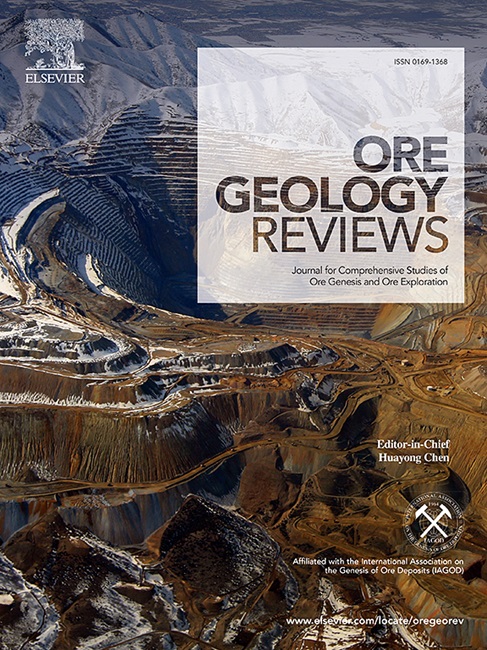An Early Cretaceous Tin-polymetallic system: The Baiyinchagan giant deposit in the southern Great Xing’an Range, North China
IF 3.2
2区 地球科学
Q1 GEOLOGY
引用次数: 0
Abstract
A critical metal, tin’s mineral resources are progressively becoming scarcer. The classification of Sn deposits is intricate, and porphyry Sn deposits are less common than porphyry Cu-Mo deposits. Sn mineralization has taken place from the Proterozoic era to the Cenozoic era, during which the mineralization ages of world-class Sn deposits in regions such as Nanling, Youjiang-Guibei, and the southern Great Xing’an Range within China are predominantly concentrated in the Late Jurassic-Early Cretaceous period.
The Baiyinchagan deposit stands as a colossal porphyry-hydrothermal vein-epithermal Sn polymetallic system in the southern Great Xing’an Range. This system encompasses porphyry Sn-Cu-Ag, hydrothermal vein Sn-Ag, and epithermal Ag. The verified resources amount to 0.35 Mt of Sn at a grade of 0.75 %, 727 Moz of Ag at 164 g/t, 0.9 Mt of Pb plus Zn at 4.8 %, 0.2 Mt of Sb at 0.32 %, 0.1 Mt of Cu at 0.2 % and 3839 t of Ga at 51 g/t. Porphyry-type alterations which encompass quartz-sericite-tourmaline-muscovite and epidote-chlorite-tourmaline, are respectively correlated with the disseminated-veinlet cassiterite, chalcopyrite, arsenopyrite and tetrahedrite ore mineral assemblages, as well as low-grade disseminated cassiterite mineralization. The alterations in hydrothermal Sn polymetallic veins are typified by quartz-fluorite-tourmaline veinlets and disseminated tourmaline-sericite, all of which are associated with veinlet-stockwork, brecciated and disseminated cassiterite, chalcopyrite, sphalerite, tetrahedrite and arsenopyrite. The alterations in hydrothermal Ag polymetallic veins consist of quartz-calcite/siderite and chlorite, and is intimately related to brecciated sphalerite, galena, chalcopyrite, jamesonite and pyrite. Epithermal alteration includes quartz-illite-siderite, sericite-kaolinite and epidote-chlorite-fluorite. Sphalerite, galena, pyrargyrite, argentite and pyrite are frequently disseminated and exhibit a close relationship with quartz-illite-siderite alteration.
The petrological and geochemical traits of the Sn-Cu-Ag-bearing porphyry, quartz porphyry, albite porphyry and rhyolite within the Baiyinchagan deposit bear resemblance to those of igneous rocks in other Sn deposits in the southern Great Xing’an Range and are characteristics of A-type granites that formed in intraplate environments. The zircon Hf isotopic and trace element features of the Sn-Cu-Ag-bearing porphyry and quartz porphyry imply that the magmas were generated through partial melting of the crust with certain mantle contributions. The zircon U-Pb age of the Sn-Cu-Ag porphyry, cassiterite U-Pb age and illite K-Ar age are in accord with the ages of the A-type granites and Sn mineralization in the southern Great Xing’an Range, at 140.58 ± 0.25 Ma, 136.3 ± 4.1 Ma and 130.0 ± 1.3 Ma respectively, which indicate the igneous and mineralization ages as being in the Early Cretaceous. This paper proposes that the post-collisional setting of the Mongol-Okhotsk Ocean and the rollback of the Paleo-Pacific Plate during the Late Jurassic-Early Cretaceous led to regional extension, thereby triggering the Sn mineralization in the southern Great Xing’an Range.

求助全文
约1分钟内获得全文
求助全文
来源期刊

Ore Geology Reviews
地学-地质学
CiteScore
6.50
自引率
27.30%
发文量
546
审稿时长
22.9 weeks
期刊介绍:
Ore Geology Reviews aims to familiarize all earth scientists with recent advances in a number of interconnected disciplines related to the study of, and search for, ore deposits. The reviews range from brief to longer contributions, but the journal preferentially publishes manuscripts that fill the niche between the commonly shorter journal articles and the comprehensive book coverages, and thus has a special appeal to many authors and readers.
 求助内容:
求助内容: 应助结果提醒方式:
应助结果提醒方式:


